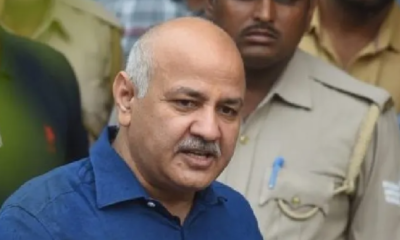Business
Clothing giant Zara’s new security tech made shoplifting easy; retailer denies claims

[ad_1]
Inditex SA is racing to iron bugs out of a new anti-shoplifting system for its Zara stores, slightly delaying its rollout partly because the security tags were easy to identify and remove in initial tests, according to people familiar with the matter.

Chief Executive Officer Oscar García Maceiras unveiled the new technology in March and pledged to roll it out for tests in all Zara stores worldwide over the summer. The system relies on tiny chips known as RFID, doing away with the hard plastic tags on garments that require checkout clerks to remove them.
The new technology has run into teething issues. Staff in several countries have raised concerns to management that the technology may actually make theft easier, according to the people, who asked not to be identified.
The problems come as retailers need to boost their defenses against an increase in shoplifting. The British Retail Consortium recently found that incidents of store theft increased by 27% last year across the UK’s 10 largest cities amid the surge in inflation. Primark is adding security guards and cameras to counter the phenomenon, the discount retailer said Tuesday.
Inditex had said it would get the technology into all its shops for testing by July, and that has yet to happen. The plan was that the chain would test the system over the autumn-winter season. Delays are in part due to supply bottlenecks, according to several of the people. The retailer downplayed the issues.
“The in-store implementation process of the new soft-alarm system, which uses several technologies, is going according to plan, without any significant incidents,” Inditex said. The retailer added that the new system hasn’t resulted in any detectable change in garment theft.
The new method, in which the tiny chips are placed on labels or inside the clothing fabric, is a key part of Inditex’s strategy to seek all the synergies it can between its e-commerce business and its brick-and-mortar store network.
Inditex’s new security system is supposed to reduce theft by 60%, according to a report by Bank of America that cited Associated Security.
Shares of Inditex were little changed in Madrid trading Tuesday. The stock has gained 45% this year as the retailer has been reporting its gross margin at record levels. Inditex is expected to report an increase of about 28% in first-half operating profit when it reports Wednesday.
Hard security tags, which require extremely strong magnets to remove, will eventually become obsolete, according to Arkansas-based retail strategist Carol Spieckerman. Still, retailers have yet to come up with a system that can fully replace them, she said.
“Theft-thwarting technology is very much in test-and-learn mode currently and everything is on the table,” she said. “Unfortunately, any solution that relies on physical tags or sewn-in chips is vulnerable to sabotage as removal techniques are discovered and promoted online.”
Inditex started testing the technology this year in some stores in Spain. Shoplifters quickly figured out how to remove the small chips, which were initially implanted into labels. Another problem is with alarms ringing when customers walked into the store to return items purchased online.
As Inditex works to integrate its online business and physical stores, it’s adding collect points for internet customers in Zara shops. Some e-commerce orders are also delivered from big shops rather than warehouses.
The new system would make those processes even more efficient, because a clerk wouldn’t need to remove the hard security tag. Plus, checkout time in brick-and-mortar shops would be reduced, and it’d become easier for Inditex to expand self-checkout.
The company said in June that it aimed to eliminate all hard tags and eventually deploy the technology across its brands.
After months of experimenting with placing tags in different places on the garment, one possible alternative is a special type of thread made of a miniature RFID tag that’s wrapped in textile yarn and sewn into garment seams, the people said.
While the new technology will add to Inditex’s rising costs, over the long-term it should help boost profit. Theft resulted in about $66 billion in lost sales for retailers in the US in 2021, according to the National Retail Federation.
Business
Biden’s Hollywood Break-Up: Celebrities Say It’s Time for a Change

As President Joe Biden nears the halfway mark of his term, a noticeable shift is occurring within Hollywood’s elite. Once a stronghold of Democratic support, a growing number of celebrities are voicing their discontent with the current administration and calling for a change in leadership.
The Growing Discontent
Policy Disagreements:Many celebrities have expressed frustration over Biden’s handling of key issues such as climate change, healthcare, and immigration. Despite campaign promises, some feel that progress has been too slow or insufficient.
Environmental advocates, in particular, have been vocal about their disappointment with the administration’s compromises on climate policy, arguing that urgent action is needed to address the climate crisis.
Cultural and Social Issues:Hollywood’s progressive base has criticized Biden for not taking a stronger stance on social justice issues. High-profile figures in the entertainment industry have called for more aggressive reforms on policing, racial equality, and LGBTQ+ rights.
The Supreme Court’s recent decisions on reproductive rights have also fueled discontent, with many feeling that the administration should have taken more decisive action to protect these rights.
Economic Concerns:Celebrities have highlighted economic disparities and the administration’s handling of the post-pandemic recovery. Rising inflation and economic instability have led some to question Biden’s economic policies and their impact on everyday Americans.
The entertainment industry itself has faced challenges, including strikes and disputes over working conditions, which some feel have not been adequately addressed by the administration.
Calls for Change New Leadership:Prominent figures in Hollywood are advocating for new leadership within the Democratic Party, suggesting that fresh faces and ideas are needed to address the current political and social climate.
Some celebrities have even hinted at support for potential challengers within the party who might better align with their progressive values and vision for the future.
Increased Activism:The dissatisfaction has led to increased political activism among celebrities, with many using their platforms to mobilize fans and encourage voter participation. Grassroots campaigns and advocacy efforts are gaining momentum as celebrities push for change.
Social media has become a powerful tool for these efforts, allowing celebrities to reach wide audiences and galvanize support for various causes and candidates.
Impact on Upcoming Elections
Influence on Voters:Hollywood celebrities have long held sway over public opinion, and their shift in support could influence voters, especially younger demographics who look up to these figures.The growing call for change may lead to a more dynamic and competitive Democratic primary, potentially reshaping the party’s platform and priorities.
Republican Opportunities:The discontent within Hollywood could also present opportunities for Republican candidates to appeal to disillusioned voters. By addressing key issues and presenting viable alternatives, Republicans may seek to capitalize on the divide within the Democratic base.
Conclusion
The evolving relationship between Hollywood and the Biden administration highlights the complexities of political alliances and the changing landscape of American politics. As celebrities increasingly voice their desire for change, their influence could play a significant role in shaping the future of the Democratic Party and the broader political discourse in the United States.
Business
The Shift from Celebrity Endorsements to Influencer Marketing

In recent years, the marketing landscape has witnessed a significant shift from traditional celebrity endorsements to influencer marketing. This evolution is driven by changes in consumer behavior, the rise of social media, and the need for more authentic and relatable brand connections.
Why the Shift is Happening
Authenticity and Relatability:Consumers increasingly seek genuine and relatable recommendations. Influencers, who often share personal stories and experiences, provide a sense of authenticity that traditional celebrity endorsements sometimes lack.
Influencers typically have a niche audience that trusts their opinions, making their endorsements feel more like personal recommendations than paid promotions.
Engagement and Interaction:Influencers engage directly with their followers through comments, likes, and direct messages, creating a two-way interaction. This engagement fosters a sense of community and trust.
Celebrities, while having large followings, often maintain a more distant relationship with their audience, which can reduce the perceived authenticity of their endorsements.
Targeted Reach:Brands can leverage influencers to reach specific demographics and niches. Influencers often cater to particular interests, allowing brands to target their marketing efforts more precisely.
Celebrity endorsements, on the other hand, tend to have a broader reach but may not effectively target specific audience segments.
Cost-Effectiveness:Working with influencers, especially micro-influencers (those with smaller, highly engaged followings), can be more cost-effective than high-profile celebrity endorsements.
Brands can collaborate with multiple influencers to achieve a wide reach at a lower cost compared to a single celebrity endorsement deal.
Content Diversity:Influencers create a variety of content formats, including videos, stories, and blog posts, offering brands multiple ways to connect with their audience. This diverse content can be more engaging and shareable.
Celebrity endorsements are often limited to traditional advertising formats, which may not resonate as effectively with modern, digital-savvy consumers.
Examples of Influencer Marketing Success
Fashion and Beauty:Brands like Glossier and Fashion Nova have leveraged influencers to build their brands. Influencers’ reviews, tutorials, and unboxing videos have driven significant brand awareness and sales.
Travel and Lifestyle:Companies like Airbnb and GoPro collaborate with travel influencers to showcase their products in real-life scenarios. Influencer-generated content highlights authentic travel experiences and inspires followers.
Fitness and Wellness:Fitness brands such as Gymshark have grown exponentially by partnering with fitness influencers who demonstrate the use of their products, share workout routines, and motivate their followers.
Conclusion
The shift from celebrity endorsements to influencer marketing reflects a broader trend towards authenticity, engagement, and targeted reach in the digital age. While celebrities still hold significant influence, the rise of social media has democratized marketing, allowing influencers to build strong, loyal communities. Brands that adapt to this shift and leverage the power of influencer marketing can create more meaningful connections with their audience, ultimately driving greater brand loyalty and success.
Business
Virat Kohli Surpasses Shah Rukh Khan and Ranveer Singh to Become King of Celebrity Brand Value

In the ever-evolving landscape of celebrity endorsements and brand associations, Virat Kohli has achieved a significant milestone by surpassing Bollywood icons Shah Rukh Khan and Ranveer Singh to become the king of celebrity brand value in India. This accomplishment underscores Kohli’s unparalleled popularity and influence, extending beyond the cricket field to a dominant presence in the advertising and branding world.
How Celebrity Brand Value is CalculatedCelebrity brand value is a metric that evaluates the monetary worth a celebrity brings to a brand through their endorsements. The calculation of this value involves several factors:
Marketability and Endorsement Deals: The number and nature of endorsement deals a celebrity secures play a crucial role. Higher and more lucrative deals increase the brand value.
Public Perception and Popularity: Surveys and market research assess the celebrity’s popularity, likability, and public perception. Positive sentiment and a strong fan base contribute significantly to brand value.
Media Presence and Visibility: The frequency and nature of a celebrity’s appearances in media, including social media, television, and print, impact their brand value. Greater visibility often translates to higher brand value.
Social Media Influence: In today’s digital age, a celebrity’s social media presence and engagement are vital. High follower counts and interaction rates boost brand value.
Impact on Sales and Brand Image: The effectiveness of a celebrity in driving sales and enhancing a brand’s image is a direct indicator of their brand value. Brands track the performance of campaigns featuring the celebrity to gauge this impact.
Longevity and Consistency: The duration of a celebrity’s relevance and their ability to maintain consistent performance over time contribute to their overall brand value.
Virat Kohli’s ascent to the top is a testament to his exceptional marketability, vast popularity, and strategic brand associations. His strong social media presence, consistent performance as a cricketer, and charismatic personality have all played pivotal roles in elevating his brand value. By surpassing established Bollywood stars like Shah Rukh Khan and Ranveer Singh, Kohli has solidified his position as a leading figure in both sports and brand endorsements, showcasing the growing influence of athletes in the world of celebrity branding.
-

 Featured9 months ago
Featured9 months agoOnline Threats for Jewish Students in Cornell University – Flaunt Post
-

 Entertainment1 month ago
Entertainment1 month agoSamantha Gabronino, Katwalk Doll Queen, Wins Miss Freedom of the World Grand Prix Title
-

 Sports11 months ago
Sports11 months agoWATCH: Virat Kohli Shakes A Leg On ‘Lungi Dance’ Song During India Vs Sri Lanka Asia Cup 2023 Super 4 Match
-

 Featured9 months ago
Featured9 months agoSupreme Court Delays Verdict in Manish Sisodia’s Corruption Case, Legal Battle Continues – Flaunt Post
-

 Featured10 months ago
Featured10 months agoNobel Prize 2023: Celebrating Outstanding Achievements in Science, Medicine, and Literature – Flaunt Post
-

 Entertainment10 months ago
Entertainment10 months agoOne Piece Live-Action Series Sparks Hilarity and Spice in Netflix’s Fan-Fueled Promotions – Flaunt Post
-

 Featured3 months ago
Featured3 months agoSerena Novikov: Modeling Success in the Digital World
-

 Featured9 months ago
Featured9 months agoWarning for increased terror threat by FBI director – Flaunt Post
